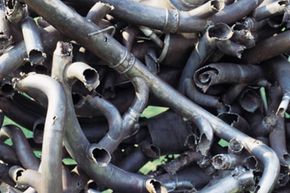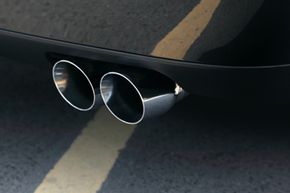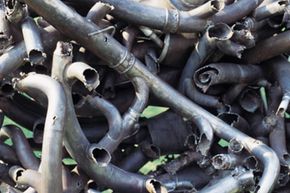\”

Truthfully, an individual car\’s emissions are relatively low, compared to other sources of pollution. But when hundreds of thousands of people are each sitting in a car, packing a highway to capacity, the cumulative effects are enormous. As you\’re sitting in a traffic jam, gazing at the smoke coming out of the tailpipe in front of you and rising to join the smog in the sky, think for a moment about what that smoke is. It might not look like much, but that smoke has come a long way since it was pushed through the car\’s engine just moments before.
Concern about our automobiles\’ effect on the environment is nothing new. The 1970 version of the Clean Air Act gave the EPA its sweeping authority to regulate automotive emissions. As technology advanced, the EPA pushed for more strict standards. And while new cars are much cleaner than those of 40 years ago, people tend to drive greater distances and a lot more often today, contributing to a lot more pollution. The Clean Air Act was revamped and increased in scope in 1977, and then again in 1990.
Automotive manufacturers and parts suppliers have had to keep pace with these changes, and as you can imagine, a car\’s exhaust system has had to evolve considerably, too.
Contents
- Components of an Exhaust — Smokin' Pipes
- Other Exhaust Components — Headers, Hangers and More
- The Exit Route
- Keeping the Pipes Clean
Components of an Exhaust — Smokin' Pipes
The exhaust system is comprised mainly of pipes in several different shapes, each designed to connect to one another, and each shaped to conform to a specific part of the underside of the car. (The pipes are often bent to wrap around or otherwise accommodate other nearby components of the car, such as the axles.) Each pipe is responsible for moving the exhaust gases toward the back, but many of the segments are specialized. In other words, from the exterior, the system simply looks like a bunch of connected pipe segments that run from the engine bay to the back bumper, though some serve an additional purpose as the exhaust flows through that particular pipe.
For example, the Y pipe (which is simply, well, a Y-shaped pipe) might be installed so the end with two openings bolts up to two corresponding openings in the exhaust manifold, combining the engine\’s waste to progress through the system. Or, when installed at the back end of the car, a Y pipe can help create a dual exhaust system with a tailpipe on each side of the car (for an often sought-after sporty look). Intermediate pipes might be attached to the muffler or resonator, which are other important system components (we\’ll get to these on the next page). Balance pipes, found in dual exhaust systems, help equalize the exhaust pulses traveling under the driver and passenger sides of the car. Air gap pipes are specialized nested pipes that act as a heat shield and insulator by providing an extra layer for airflow. And the tail pipe, which is typically peeking out from underneath the rear bumper, usually has a larger opening and might be made of more substantial-looking metal, to give the appearance of a performance exhaust that\’s a common feature of high-end cars.
Though it might seem inefficient to have a ton of pipes instead of just one, really, all those segments serve a purpose. For one, bending pipes is hard work, and it\’s easier to connect small angled segments to straight pipes than it is to shape one long, expensive, heavy pipe to fit every contour of a car. Also, exhaust system components wear out at regular intervals (depending, of course, on the manufacturer, its materials, driving conditions and environmental factors). It\’s easier and less expensive to replace one rusted-out segment of pipe, banged-up muffler, or worn-out catalytic converter than it would be to install a whole new system.
You might wonder how all those pipes fit together. Well, some ends overlap, while others are mated end-to-end; but not without a little bit of assistance.
Other Exhaust Components — Headers, Hangers and More


We discussed the various pipes first, because they\’re the most visible and prevalent components of the exhaust system, and because they\’re all over the place. But the exhaust system really starts at the exhaust header (also known as the exhaust manifold). The header looks like a series of adjacent tubes stuck together (though it\’s often made of heavy-duty cast metal). It collects the exhaust directly from the engine, so it\’s designed so each opening mates up with one of the engine\’s exhaust ports, with flanges that form a tight seal to prevent exhaust from escaping. From here, the exhaust begins its flow through the various pipes and other components.
The gaskets that are fitted between each pipe play a very important role. It\’s difficult, if not impossible, to form a flawless metal-to-metal seal, so gaskets are sandwiched between each connection to prevent the poisonous gases from escaping prematurely. They\’re made of fiber or other heavy-duty, heat resistant materials, which have just enough flexibility to compress slightly when the pipes are clamped tightly together. This helps form a tight seal.
The muffler is another key part of the exhaust system. It looks like a large round or oval chamber (usually, but not always, found near the back of the car). That chamber has a very complex design, though — it\’s responsible for silencing most of the engine\’s noise, even though it has to allow the exhaust to continue flowing smoothly. A series of chambers and tubes, filled with rock, wool, or synthetic fibers, absorbs and controls the noise. And that\’s not all — the muffler must be reasonably resistant to damage, corrosion and heat retention. The resonator is a secondary or substitute sound elimination component, used to augment the muffler, or in cases where space is at a premium it might even be used instead of a muffler.
Catalytic converters, which became commonplace in the 1970s, are the primary and most efficient means of reducing the level of toxins in a car\’s exhaust. The innards of a catalytic converter (or "cat") are coated with metals. Different types of catalytic converters use different combinations of platinum, palladium and rhodium. Before the exhaust reaches the cat, it contains a potent, super-toxic combination of carbon monoxide, nitrogen oxide and hydrocarbons. (When you take your car for its emissions test, these are the chemical levels that are being tested.) When these poisons come into contact with the metals coating the inside of the cat, a chemical reaction takes place that makes the exhaust gases less harmful. As the exhaust passes through the cat, the level of chemicals should be reduced enough to comply with government regulations.
We already talked about gaskets, but the exhaust system requires other basic pieces of hardware. Flanges generally serve the same purpose as gaskets, but these are made of metal (and are sometimes formed right onto the end of a pipe). Assorted clamps and brackets mount the exhaust pieces together and hold them to the vehicle, and exhaust hangers literally hang the pipes from the underbody of the car, with enough strength to keep them in place but also enough flexibility to withstand movement caused by driving. And last, but not least are the heat shields: Metal (sometimes insulated) plates that are used as an extra barrier whenever hot exhaust parts are particularly close to another part of the car or directly below the passenger compartment.
The Exit Route
If an engine ran perfectly, it would combust all its available fuel as it ran through its cycles, converting all the dirty bits to a source of power. However, leftovers exist as pollutants because an engine simply cannot be engineered to run perfectly — there are far too many variables. Some amount of fuel will always remain unburned or partially burned, and these remnants must be quickly processed out of the vehicle, in the form of exhaust, to make room for the next cycle of engine combustion.
As we mentioned earlier, the exhaust first exits the engine and enters the system through the exhaust manifold. From there, it travels down the system through interconnected pipes until it exits through the tailpipe, near the back bumper. The pipes themselves actually help cool the exhaust, but they\’re mostly a way for the exhaust to travel to (and through) the catalytic converter and muffler.
The cat has to be as close to the engine as possible, because it isn\’t fully functional until it rises to operating temperature. In many cases, the manufacturer places the cat shortly after the manifold, so heat from the engine helps warm the cat and quickly bring it up to temp.
After the gases pass through the cat, which will burn off and remove up to 90 percent of the exhaust\’s toxins, the next priority is to filter the engine sound [source: Allen]. The muffler and resonator are usually situated right beyond the cat. There are many variations on this combination — some will soothe the exhaust as much as possible, while others are specifically tuned for aggressive tones. From there, the exhaust moves through the remainder of the pipes until it exits the car.
With all those chemicals swirling around, it\’s quite a feat that the exhaust system actually works as well as it does. A well-maintained exhaust system should last two to three years, but the pipes incur damage both inside and out. On the outside, they\’re susceptible to road conditions, such as impact from debris and environmental factors, such as snow, ice and road salt.
However, a more substantial cause of exhaust system degradation is internal, and it can\’t be seen until the pipes have corroded through with rust. We know that as the engine combusts fuel to make power, byproducts of this process are left over — that\’s why the exhaust system is needed. One of these byproducts is acidic moisture, and it\’s really damaging to metal. Unfortunately, there\’s really no way to keep the insides of the pipes clean.
When an exhaust pipe rots through or a connection comes loose, an exhaust leak occurs. A leak is almost always immediately apparent with a loud, obnoxious sound and, possibly, drivability issues like an intermittent fluctuation in power. But, believe it or not, these aren\’t the real problems. It gets a little more serious if the leak occurs before the catalytic converter, which means the exhaust isn\’t being properly processed and all those hot chemicals are spilling everywhere into the atmosphere. It\’s always a good idea to get leaks fixed as soon as possible to avoid subjecting yourself, your passengers and your surroundings to unfiltered exhaust fumes.
Keeping the Pipes Clean


Diesel engines, often blamed for disproportionately high levels of toxic emissions, may find their reputation salvaged somewhat by new and improved exhaust filters that claim to reduce emissions by about 25 percent, with the added benefit of increasing fuel economy. Several automotive manufacturers with a history of offering diesel models have introduced similar systems that combine high-powered catalytic converters with diesel particulate filters. Volkswagen\’s BlueMotion turbodiesel lineup (sold mostly in Europe and South America) and Mercedes\’ BlueTec diesels are two such examples. In many cases, these OEM components and car models use weight reduction and other streamlining techniques to improve overall efficiency.
Improved exhaust efficiency is critical to getting the most out of your car, and there are even ways to improve an older car (assuming it\’s in generally good condition — a performance exhaust system won\’t work miracles on a total jalopy). A mechanic can usually order identical original replacement parts, but there are also alternatives from aftermarket performance parts suppliers that often give the car a facelift (at least, as much as the car\’s underbody can be spruced up, anyway). There are several frequently-mentioned benefits of performance exhaust systems. Aftermarket manufacturers are well aware that the auditory experience is critical to a pleasurable drive, and it also lets nearby drivers know that a little extra coin was spent on the car, too. Most manufacturers offer a variety of systems that range in sound from a subtle throatiness to an all-out roar. A good aftermarket performance exhaust can improve throttle response (how fast, and smoothly, the car reacts to the pressure applied to the gas pedal) and give a boost in horsepower. Some systems can even improve fuel economy. Performance exhausts are able to provide this power boost because they\’re less restrictive than stock exhausts. If the engine can push out more air (which also means it can take in more air) that helps the engine make more power. But contrary to what you might think, a totally free-flowing system will be counterproductive. Aftermarket exhausts are engineered to provide just the right amount of back pressure so that the engine doesn\’t end up running at sub-peak output. That\’s why it\’s important to choose one designed and optimized for your specific vehicle. And before you go ripping out your exhaust pipes, make sure the system you want is street-legal and won\’t cause your car to fail its emissions test.
Understand, too, that a real performance exhaust system cannot provide mind-blowing benefits for a trivial investment. Beware of cheap products like clip-on or screw-on "performance" exhaust system components or exhaust tips that claim to give the look of a full performance system. They won\’t help the car\’s drivability and they may even hinder it by adding extra weight and wind resistance. And besides, those gaudy tips really aren\’t fooling anyone.
Originally Published: Feb 23, 2012
Auto Exhaust System FAQ
How much does it cost to replace an exhaust pipe?
According to Repair Pal, it costs between $803 and $830 to replace an exhaust pipe.
What are the parts of an exhaust system?
The exhaust header, exhaust pipes, gaskets, muffler and catalytic converters are some parts of the exhaust system.
What do exhaust pipes do?
Each pipe is responsible for moving the exhaust gases toward the back, but many of the segments are specialized.
Do exhaust systems add horsepower?
Yes, a good aftermarket performance exhaust can improve throttle response and give a boost in horsepower.
Is it bad to have a hole in your exhaust pipe?
Yes. Exhaust fumes can leak into your vehicle, putting you at risk of carbon monoxide poisoning.
Lots More Information
Related Articles
- How Mufflers Work
- How Car Engines Work
- How Catalytic Converters Work
- How Diesel Engines Work
- How do exhaust headers work to improve engine performance?
Sources
- Abuelsamid, Sam. "Useless Car Performance Add-Ons." Popular Mechanics. (Jan. 29, 2012) http://www.popularmechanics.com/cars/how-to/products/performance-sapping-aftermarket-add-ons
- Allen, Mike. "How to Install a Cat-back Exhaust System." Popular Mechanics. Dec. 18, 2009. (Jan. 29, 2012) http://www.popularmechanics.com/cars/how-to/maintenance/4270747
- Dow Automotive Systems. "Automotive — Reducing Exhaust Emissions." (Jan. 29, 2012) http://www.dowautomotive.com/capabilities/industry/automotive/reducing.htm
- Flowmaster. "Performance Exhaust Systems." 2011. (Jan. 29, 2012) http://www.flowmastermufflers.com/index.php?cat=2
- U.S. Environmental Protection Agency Office of Mobile Sources. "Automobile Emissions — An Overview." August 1994. (Jan. 29, 2012) http://www.epa.gov/otaq/consumer/05-autos.pdf
- Walker Exhaust. "Walker Exhaust 101." (Jan. 29, 2012) http://www.walkerexhaust.com/support/exhaust101/componentsAndDesign.asp












